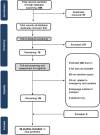Emergency care in post-conflict settings: a systematic literature review
- PMID: 37005602
- PMCID: PMC10068156
- DOI: 10.1186/s12873-023-00775-0
Emergency care in post-conflict settings: a systematic literature review
Abstract
Background: Emergency care systems (ECS) organize and provide access to life-saving care both during transport and at health facilities. Not enough is known about ECS in uncertain contexts such as post-conflict settings. This review aims to systematically identify and summarize the published evidence on the delivery of emergency care in post-conflict settings and to guide health sector planning.
Methods: We searched five databases (PubMed MEDLINE, Web of Science, Embase, Scopus, and Cochrane) in September 2021 to identify relevant articles on ECS in post-conflict settings. Included studies (1) described a context that is post-conflict, conflict-affected, or was impacted by war or crisis; (2) examined the delivery of an emergency care system function; (3) were available in English, Spanish, or French; and (4) were published between 1 and 2000 and 9 September 2021. Data were extracted and mapped using the essential system functions identified in the World Health Organization (WHO) ECS Framework to capture findings on essential emergency care functions at the scene of injury or illness, during transport, and through to the emergency unit and early inpatient care.
Results: We identified studies that describe the unique burden of disease and challenges in delivering to the populations in these states, pointing to particular gaps in prehospital care delivery (both during scene response and during transport). Common barriers include poor infrastructure, lingering social distrust, scarce formal emergency care training, and lack of resources and supplies.
Conclusion: To our knowledge, this is the first study to systematically identify the evidence on ECS in fragile and conflict-affected settings. Aligning ECS with existing global health priorities would ensure access to these critical life-saving interventions, yet there is concern over the lack of investments in frontline emergency care. An understanding of the state of ECS in post-conflict settings is emerging, although current evidence related to best practices and interventions is extremely limited. Careful attention should be paid to addressing the common barriers and context-relevant priorities in ECS, such as strengthening prehospital care delivery, triage, and referral systems and training the health workforce in emergency care principles.
Keywords: Emergency care; Post-conflict settings; Systematic review.
© 2023. The Author(s).
Conflict of interest statement
The authors declare no conflicts of interest.
Figures
References
-
- WHO. WHO Emergency Care System Framework infographic [Internet]. 2019. Available from: https://www.who.int/emergencycare/emergencycare_infographic/en/.
Publication types
MeSH terms
LinkOut - more resources
Full Text Sources
Medical



